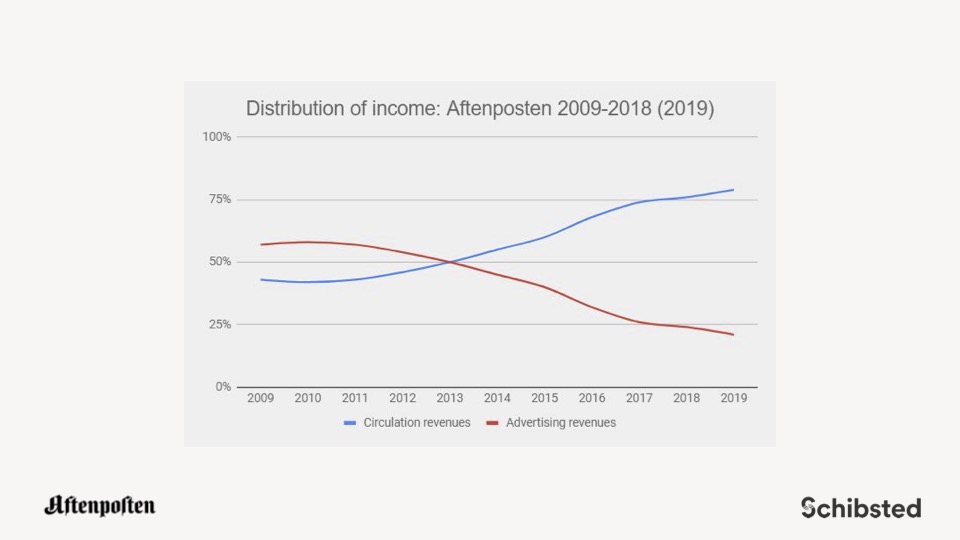
Newsletter
Newsletter
In this week’s bulletin, we review Aftenposten’s sophisticated retention strategy that includes age-based segmentation and subscription sharing.
24th August 2022

In the Pugpig weekly media bulletin, Pugpig’s consulting services director Kevin Anderson distills some of the best strategies and tactics that are driving growth in audiences, revenue and innovation at media businesses around the world.
Many publishers have shifted away from a reliance on advertising as a primary source of revenue, with some, like Norway’s Aftenposten, now earning 80% of its revenue from its subscribers. Circulation revenues overtook advertising revenue in 2013, and subscribers have only grown as a percentage of the paper’s revenues since then.
Sign up to get the Media Bulletin in your inbox.

The Schibsted-owned paper now has some 150,000 paying digital-only subscribers, and at WAN-IFRA’s Digital Media Europe Conference, Schibsted’s Sidney Glastad outlined how the paper attracts and retains these paying customers and constantly adjusts its efforts based on data and changing market conditions.
They have such an excellent playbook that really shows how experimentation, constantly demonstrating value and understanding their users deliver great results. And as publishers focus on retention, it has a lot of lessons on how to keep your paying subscribers as we enter challenging economic times.
Case in point, they allow people to share their subscriptions with someone, as people often do. Just think of Netflix account sharing. If someone goes to cancel their subscription, they are reminded about the person sharing their account as well, which has helped reduce churn.
They also have an age-based onboarding strategy for new subscribers that runs from the first day to the 52nd. Age-based? They communicate differently with their subscribers based on how old they are. For instance, each week, subscribers get offers from their loyalty programme, and you can imagine that offers are different for a 30-year-old subscriber versus an older, possibly retired one.
The work is one of constant adaption though. They have found that a Norwegian bank has begun to offer a service that alerts people to subscriptions that they may have forgotten, giving them the ability to cancel. Publishers will often speak of sleeper or ghost subscribers, and keeping people engaged with your products will require organisations to remain nimble.
In so many of the examples that we highlight each week, data is an important element. Schibsted has long used data to drive its experiments and fine-tune its subscription strategies, and it informs product development and management as in our final example today. The success of publishers is closely linked to the sophistication with which they use data, and Ariane Bernard, the smart data initiative lead at INMA, says that eight months of leading the project has led her to break down the maturity in data use at publishers into three stages:
Bernard does an excellent job of highlighting not only the features of being in each stage but also providing some brief case studies of how various businesses have moved through the stages. Most media companies are using analytics, and in Stage 1, they usually have an analyst supporting content teams for audience development.
“The Stage 2 of the data team seems to often get reached when analytics moves from being strictly a content engagement play to supporting a plan for direct reader revenue or complex advertising sales,” she says. For instance, at Kleine Zeitung in Austria, Sanda Loncar, head of product and data, discussed how they moved a data analyst into her team. The growing sophistication of Stage 2 organisations means that they start to model complex user acquisition funnels and to leverage more first-party data, which has become critical as Google and Apple start to crack down on third-party data in their own business interests but also to respond to privacy concerns by users.
As she examined the increasing data sophistication of the companies she profiled across Europe, she found a common pivot point: They hired a data scientist. The hire allowed them to move beyond simply looking for information in the data they had to creating predictive models that find the most interesting insights in the data. “This shift in mindset leads to that first data science hire. And the team there also reframes its role from being a service to the questions of other groups to taking the lead on bringing the company insights and predictions — letting the data tell stories about your users or business and giving answers to questions you were not asking,” Bernard said.
Publishers have been through a number of different shifts over the past decades, and we can see in the previous examples today, the shift can be in the revenue mix or in their use of data. One of the most important shifts that began more than a decade ago at larger organisations and has filtered down to publishers of all sizes has been product thinking. In a brilliant newsletter, David I. Adeleke describes product thinking as:
simply the idea that you first seek to understand your user’s problem, contextualise that problem, and then design products to solve it.
David I. Adeleke, Publisher, CMQ Media, Communications Lead, Nestcoin & Managing Editor, Breach.
Product management has been around for almost a century, starting first at consumer goods giant Proctor and Gamble as they assigned a product manager to be responsible for the success of a soap brand that was languishing. Adeleke demonstrates how product management has made its way into media organisations through a series of case studies in the African media market. In the case of Stears Business, he highlights how they realised that they weren’t hitting their engagement targets with their subscription product so they found out why by interviewing their users.
“Our customers were telling us how they were consistently missing our emails, our daily briefings, or how they didn’t want to read across the various sectors we covered. Basically, they wanted a lot more focus, and we were writing too broadly for them,” Yvette Uloma Dimiri, the company’s Head of Subscription Growth and former Product Manager, said. They also wanted to be able to save articles that they cared about and discover other things that they might be interested in, which informed how their app.
Pugpig has done this kind of work with clients in the past, and we are expanding this support with Pugpig Consulting Services. We will help you with user research for your app or site so that you hit your audience growth, engagement and revenue targets. We want you to be as successful as possible using our platform. Get in touch.
Here are some of the most important headlines about the business of news and publishing as well as strategies and tactics in product management, analytics and audience engagement.

Newsletter

Newsletter

Newsletter

Newsletter

Newsletter